Abstract
1. The potentiating effect of NG-nitro-L-arginine methyl ester, (L-NAME) a nitric oxide synthesis inhibitor, on responses of the rat pulmonary vascular pressure (PVP) to purinoceptor agonists was examined. 2. At a constant flow of 23 ml min-1 the PVP was 22.4 +/- 2.5 mmHg (n = 15), and treatment with 100 microM L-NAME for 15 min was without effect on the PVP. After the tone was raised with 28 nmol 9,11-dideoxy-11 alpha, 9 alpha-epoxymethano-prostaglandin F2 alpha (U-46619), the PVP was 29.4 +/- 3.3 mmHg and treatment with 100 microM L-NAME was still without effect on the PVP. It appears that there is a graded release of nitric oxide in response to different levels of steady shear stress and in our experimental model the threshold for detection was not reached under basal conditions. 3. In contrast, when the circulation was challenged with 30 s step, additive increases in flow between 11 and 50 ml min-1 (n = 8), treatment with 100 microM L-NAME produced a significant (P < 0.05) increase in PVP suggesting that changes in flow-derived forces evoke the release of nitric oxide. This was evident for flow rates above 30 ml min-1. 4. In preparations in which tone was raised with U-46619, a dose of 1 x 10(-8) mol ATP or 2-meSATP evoked a drop in PVP while alpha,beta-meATP produced an increase in PVP under constant flow of 23 ml min-1. After treatment with 100 microM L-NAME, all three purinoceptor agonists evoked an increase in PVP.(ABSTRACT TRUNCATED AT 250 WORDS)
Full text
PDF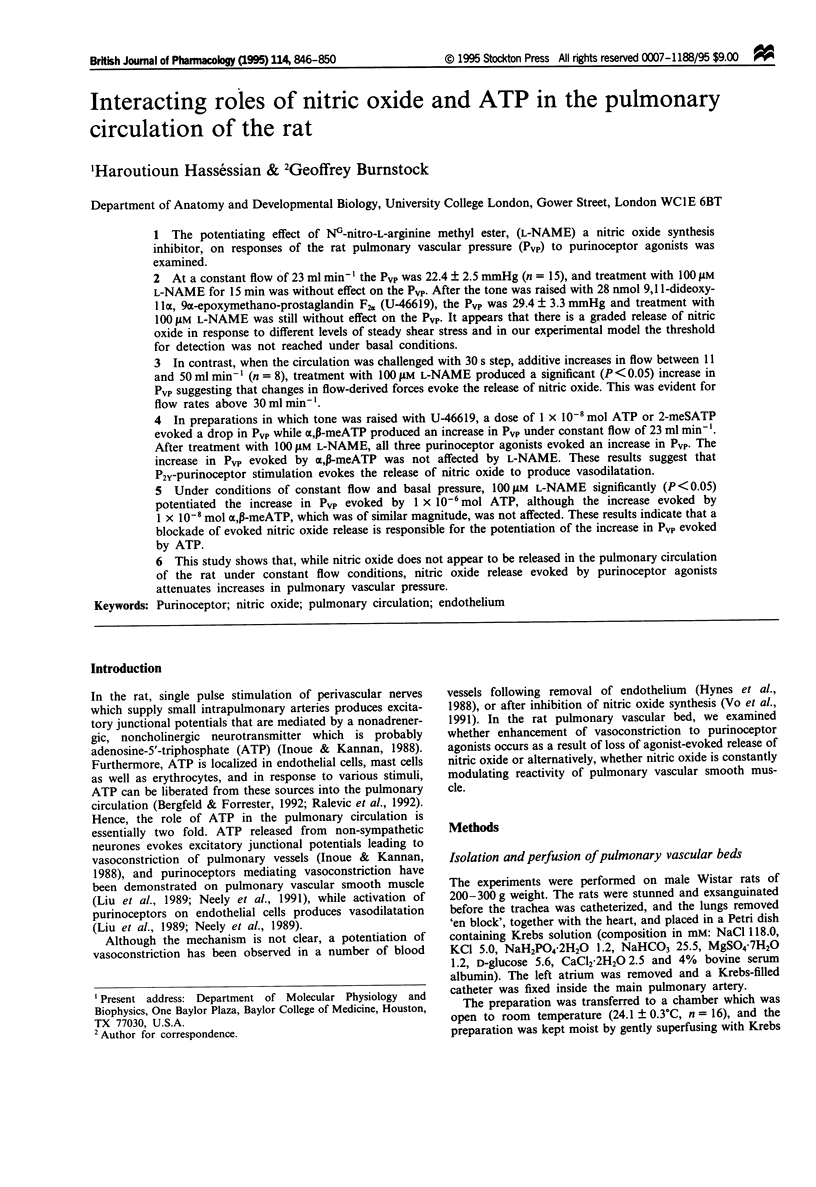
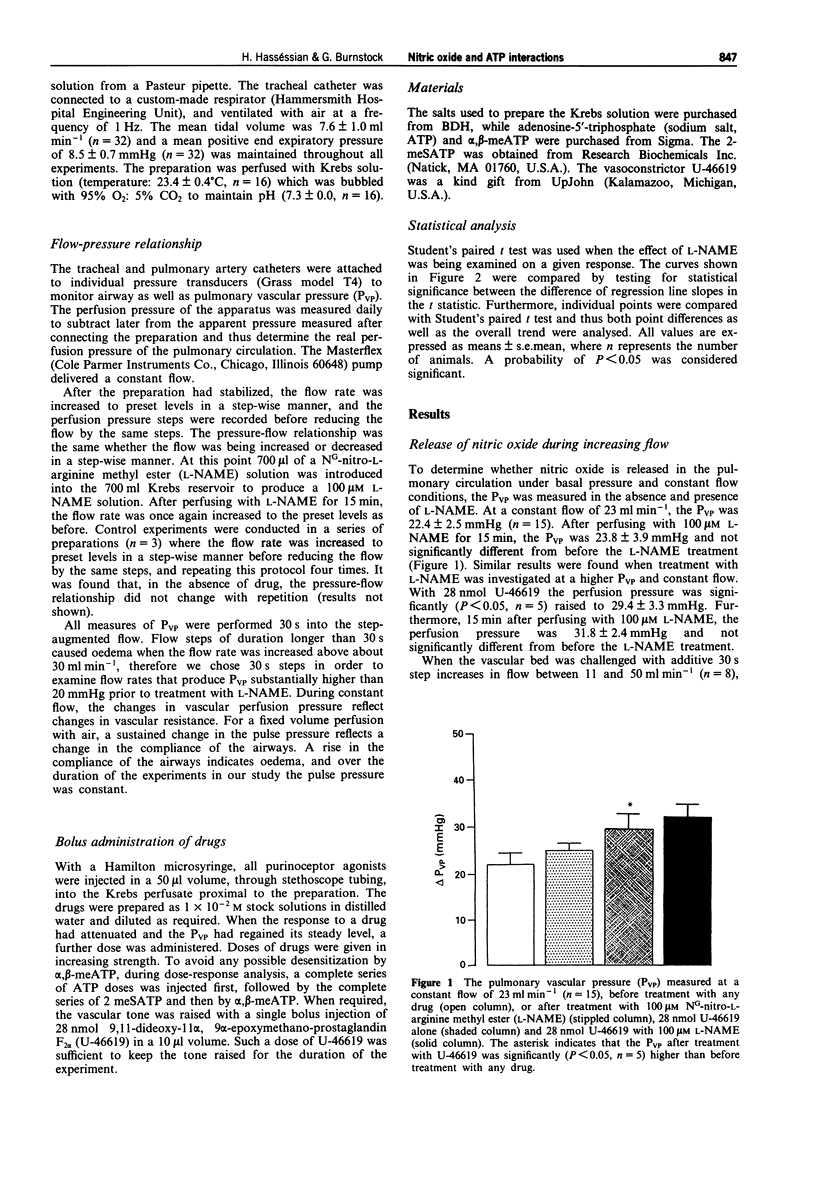
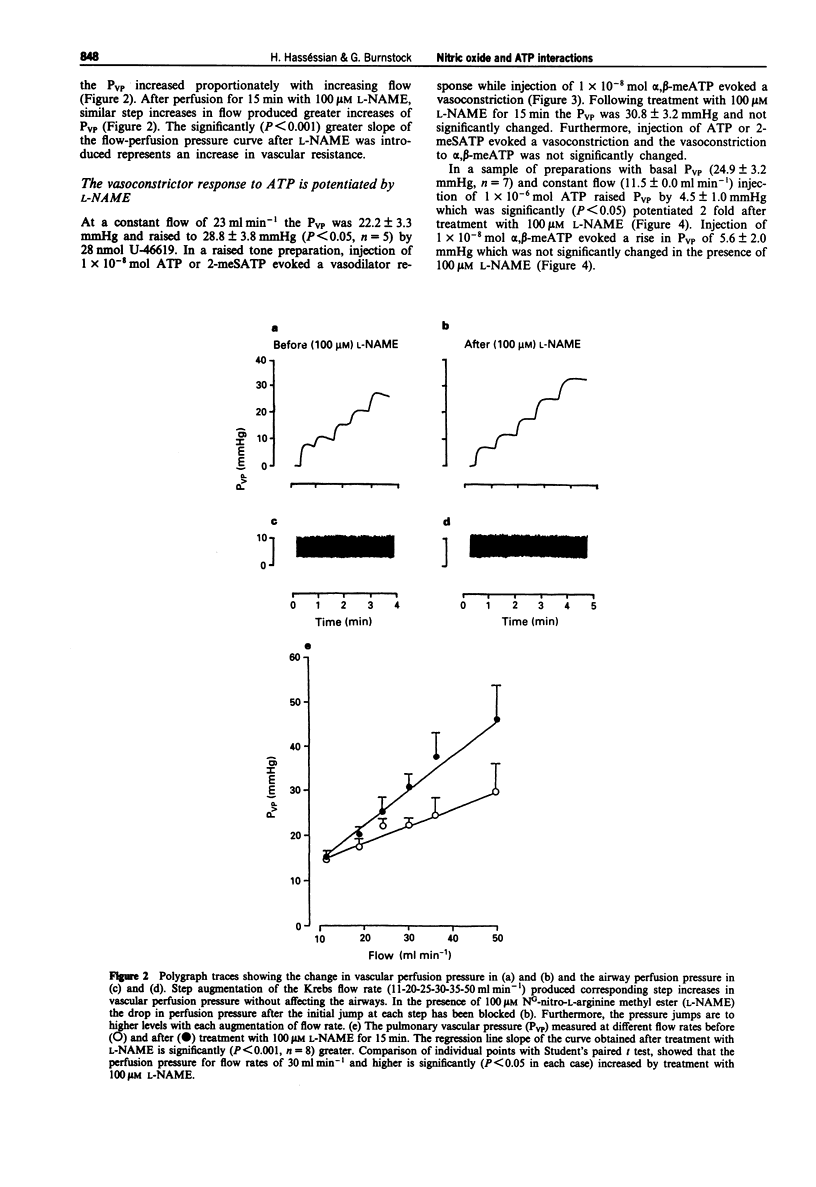
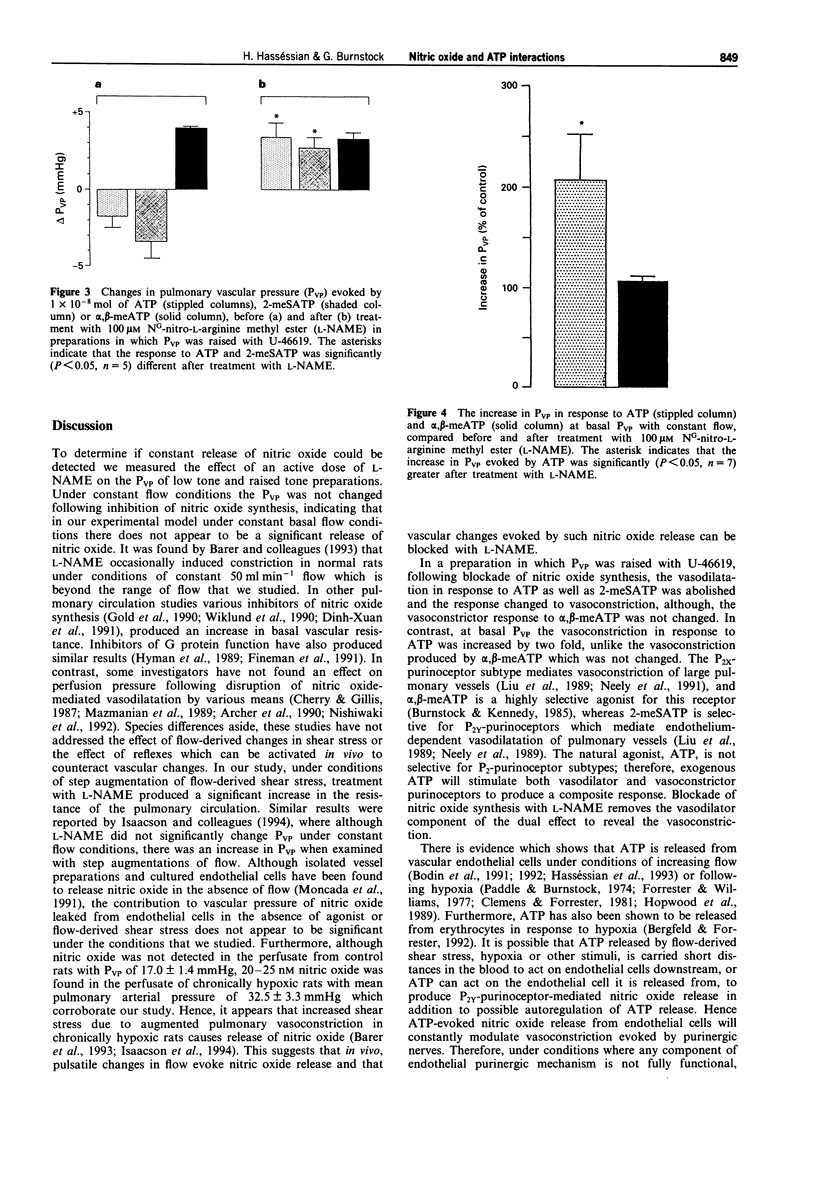
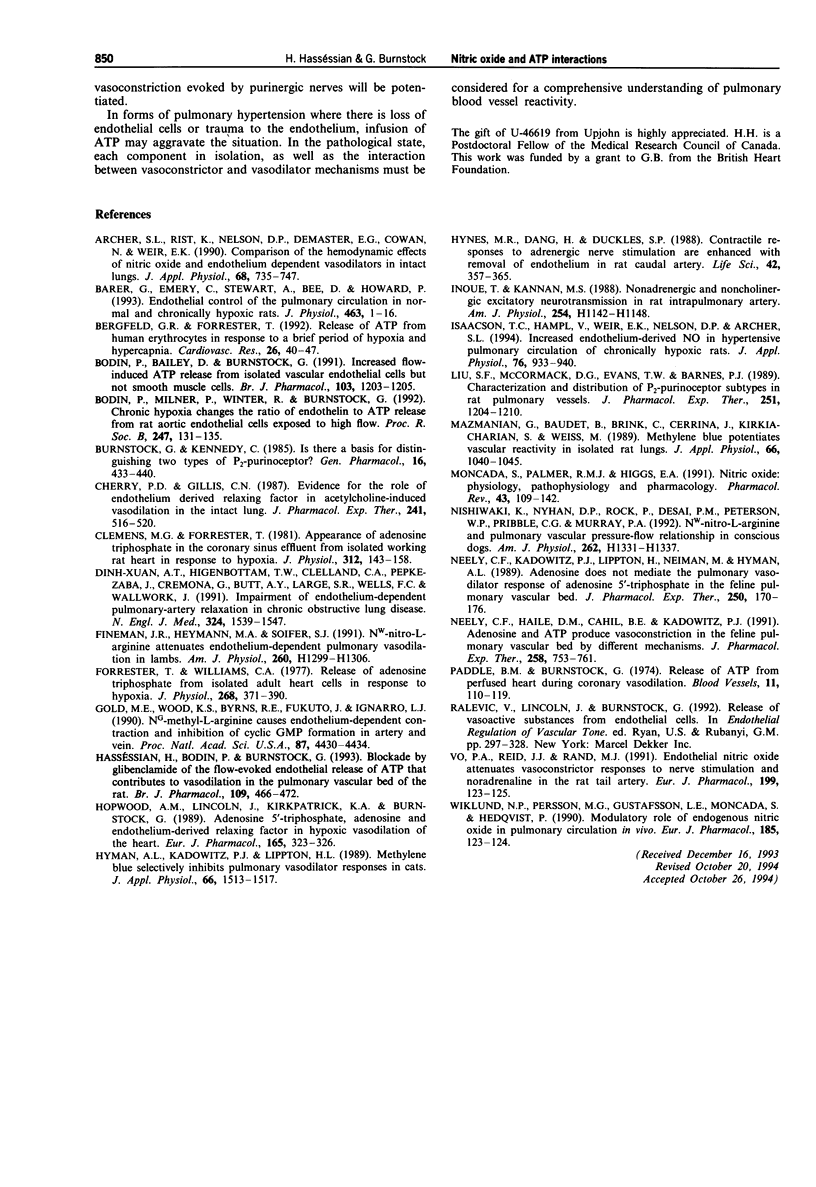
Selected References
These references are in PubMed. This may not be the complete list of references from this article.
- Archer S. L., Rist K., Nelson D. P., DeMaster E. G., Cowan N., Weir E. K. Comparison of the hemodynamic effects of nitric oxide and endothelium-dependent vasodilators in intact lungs. J Appl Physiol (1985) 1990 Feb;68(2):735–747. doi: 10.1152/jappl.1990.68.2.735. [DOI] [PubMed] [Google Scholar]
- Barer G., Emery C., Stewart A., Bee D., Howard P. Endothelial control of the pulmonary circulation in normal and chronically hypoxic rats. J Physiol. 1993 Apr;463:1–16. doi: 10.1113/jphysiol.1993.sp019581. [DOI] [PMC free article] [PubMed] [Google Scholar]
- Bergfeld G. R., Forrester T. Release of ATP from human erythrocytes in response to a brief period of hypoxia and hypercapnia. Cardiovasc Res. 1992 Jan;26(1):40–47. doi: 10.1093/cvr/26.1.40. [DOI] [PubMed] [Google Scholar]
- Bodin P., Bailey D., Burnstock G. Increased flow-induced ATP release from isolated vascular endothelial cells but not smooth muscle cells. Br J Pharmacol. 1991 May;103(1):1203–1205. doi: 10.1111/j.1476-5381.1991.tb12324.x. [DOI] [PMC free article] [PubMed] [Google Scholar]
- Bodin P., Milner P., Winter R., Burnstock G. Chronic hypoxia changes the ratio of endothelin to ATP release from rat aortic endothelial cells exposed to high flow. Proc Biol Sci. 1992 Feb 22;247(1319):131–135. doi: 10.1098/rspb.1992.0019. [DOI] [PubMed] [Google Scholar]
- Burnstock G., Kennedy C. Is there a basis for distinguishing two types of P2-purinoceptor? Gen Pharmacol. 1985;16(5):433–440. doi: 10.1016/0306-3623(85)90001-1. [DOI] [PubMed] [Google Scholar]
- Cherry P. D., Gillis C. N. Evidence for the role of endothelium-derived relaxing factor in acetylcholine-induced vasodilatation in the intact lung. J Pharmacol Exp Ther. 1987 May;241(2):516–520. [PubMed] [Google Scholar]
- Clemens M. G., Forrester T. Appearance of adenosine triphosphate in the coronary sinus effluent from isolated working rat heart in response to hypoxia. J Physiol. 1981 Mar;312:143–158. doi: 10.1113/jphysiol.1981.sp013621. [DOI] [PMC free article] [PubMed] [Google Scholar]
- Dinh-Xuan A. T., Higenbottam T. W., Clelland C. A., Pepke-Zaba J., Cremona G., Butt A. Y., Large S. R., Wells F. C., Wallwork J. Impairment of endothelium-dependent pulmonary-artery relaxation in chronic obstructive lung disease. N Engl J Med. 1991 May 30;324(22):1539–1547. doi: 10.1056/NEJM199105303242203. [DOI] [PubMed] [Google Scholar]
- Fineman J. R., Heymann M. A., Soifer S. J. N omega-nitro-L-arginine attenuates endothelium-dependent pulmonary vasodilation in lambs. Am J Physiol. 1991 Apr;260(4 Pt 2):H1299–H1306. doi: 10.1152/ajpheart.1991.260.4.H1299. [DOI] [PubMed] [Google Scholar]
- Forrester T., Williams C. A. Release of adenosine triphosphate from isolated adult heart cells in response to hypoxia. J Physiol. 1977 Jun;268(2):371–390. doi: 10.1113/jphysiol.1977.sp011862. [DOI] [PMC free article] [PubMed] [Google Scholar]
- Gold M. E., Wood K. S., Byrns R. E., Fukuto J., Ignarro L. J. NG-methyl-L-arginine causes endothelium-dependent contraction and inhibition of cyclic GMP formation in artery and vein. Proc Natl Acad Sci U S A. 1990 Jun;87(12):4430–4434. doi: 10.1073/pnas.87.12.4430. [DOI] [PMC free article] [PubMed] [Google Scholar]
- Hasséssian H., Bodin P., Burnstock G. Blockade by glibenclamide of the flow-evoked endothelial release of ATP that contributes to vasodilatation in the pulmonary vascular bed of the rat. Br J Pharmacol. 1993 Jun;109(2):466–472. doi: 10.1111/j.1476-5381.1993.tb13592.x. [DOI] [PMC free article] [PubMed] [Google Scholar]
- Hopwood A. M., Lincoln J., Kirkpatrick K. A., Burnstock G. Adenosine 5'-triphosphate, adenosine and endothelium-derived relaxing factor in hypoxic vasodilatation of the heart. Eur J Pharmacol. 1989 Jun 20;165(2-3):323–326. doi: 10.1016/0014-2999(89)90730-9. [DOI] [PubMed] [Google Scholar]
- Hyman A. L., Kadowitz P. J., Lippton H. L. Methylene blue selectively inhibits pulmonary vasodilator responses in cats. J Appl Physiol (1985) 1989 Mar;66(3):1513–1517. doi: 10.1152/jappl.1989.66.3.1513. [DOI] [PubMed] [Google Scholar]
- Hynes M. R., Dang H., Duckles S. P. Contractile responses to adrenergic nerve stimulation are enhanced with removal of endothelium in rat caudal artery. Life Sci. 1988;42(4):357–365. doi: 10.1016/0024-3205(88)90073-2. [DOI] [PubMed] [Google Scholar]
- Inoue T., Kannan M. S. Nonadrenergic and noncholinergic excitatory neurotransmission in rat intrapulmonary artery. Am J Physiol. 1988 Jun;254(6 Pt 2):H1142–H1148. doi: 10.1152/ajpheart.1988.254.6.H1142. [DOI] [PubMed] [Google Scholar]
- Isaacson T. C., Hampl V., Weir E. K., Nelson D. P., Archer S. L. Increased endothelium-derived NO in hypertensive pulmonary circulation of chronically hypoxic rats. J Appl Physiol (1985) 1994 Feb;76(2):933–940. doi: 10.1152/jappl.1994.76.2.933. [DOI] [PubMed] [Google Scholar]
- Liu S. F., McCormack D. G., Evans T. W., Barnes P. J. Characterization and distribution of P2-purinoceptor subtypes in rat pulmonary vessels. J Pharmacol Exp Ther. 1989 Dec;251(3):1204–1210. [PubMed] [Google Scholar]
- Mazmanian G. M., Baudet B., Brink C., Cerrina J., Kirkiacharian S., Weiss M. Methylene blue potentiates vascular reactivity in isolated rat lungs. J Appl Physiol (1985) 1989 Mar;66(3):1040–1045. doi: 10.1152/jappl.1989.66.3.1040. [DOI] [PubMed] [Google Scholar]
- Moncada S., Palmer R. M., Higgs E. A. Nitric oxide: physiology, pathophysiology, and pharmacology. Pharmacol Rev. 1991 Jun;43(2):109–142. [PubMed] [Google Scholar]
- Neely C. F., Haile D. M., Cahill B. E., Kadowitz P. J. Adenosine and ATP produce vasoconstriction in the feline pulmonary vascular bed by different mechanisms. J Pharmacol Exp Ther. 1991 Sep;258(3):753–761. [PubMed] [Google Scholar]
- Neely C. F., Kadowitz P. J., Lippton H., Neiman M., Hyman A. L. Adenosine does not mediate the pulmonary vasodilator response of adenosine 5'-triphosphate in the feline pulmonary vascular bed. J Pharmacol Exp Ther. 1989 Jul;250(1):170–176. [PubMed] [Google Scholar]
- Nishiwaki K., Nyhan D. P., Rock P., Desai P. M., Peterson W. P., Pribble C. G., Murray P. A. N omega-nitro-L-arginine and pulmonary vascular pressure-flow relationship in conscious dogs. Am J Physiol. 1992 May;262(5 Pt 2):H1331–H1337. doi: 10.1152/ajpheart.1992.262.5.H1331. [DOI] [PubMed] [Google Scholar]
- Paddle B. M., Burnstock G. Release of ATP from perfused heart during coronary vasodilatation. Blood Vessels. 1974;11(3):110–119. doi: 10.1159/000158005. [DOI] [PubMed] [Google Scholar]
- Vo P. A., Reid J. J., Rand M. J. Endothelial nitric oxide attenuates vasoconstrictor responses to nerve stimulation and noradrenaline in the rat tail artery. Eur J Pharmacol. 1991 Jun 18;199(1):123–125. doi: 10.1016/0014-2999(91)90647-9. [DOI] [PubMed] [Google Scholar]
- Wiklund N. P., Persson M. G., Gustafsson L. E., Moncada S., Hedqvist P. Modulatory role of endogenous nitric oxide in pulmonary circulation in vivo. Eur J Pharmacol. 1990 Aug 21;185(1):123–124. doi: 10.1016/0014-2999(90)90221-q. [DOI] [PubMed] [Google Scholar]


